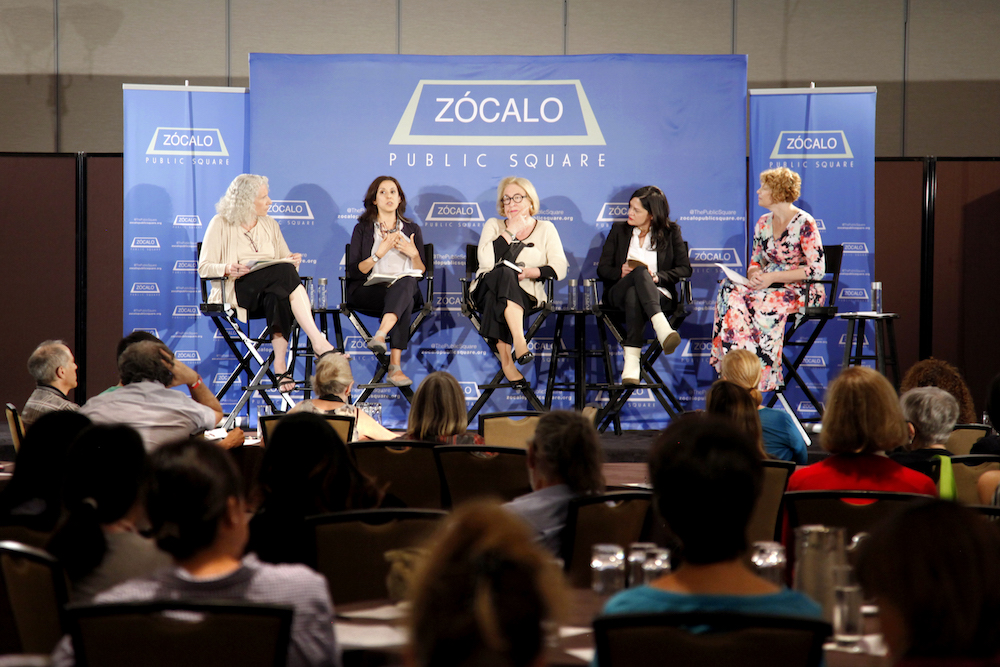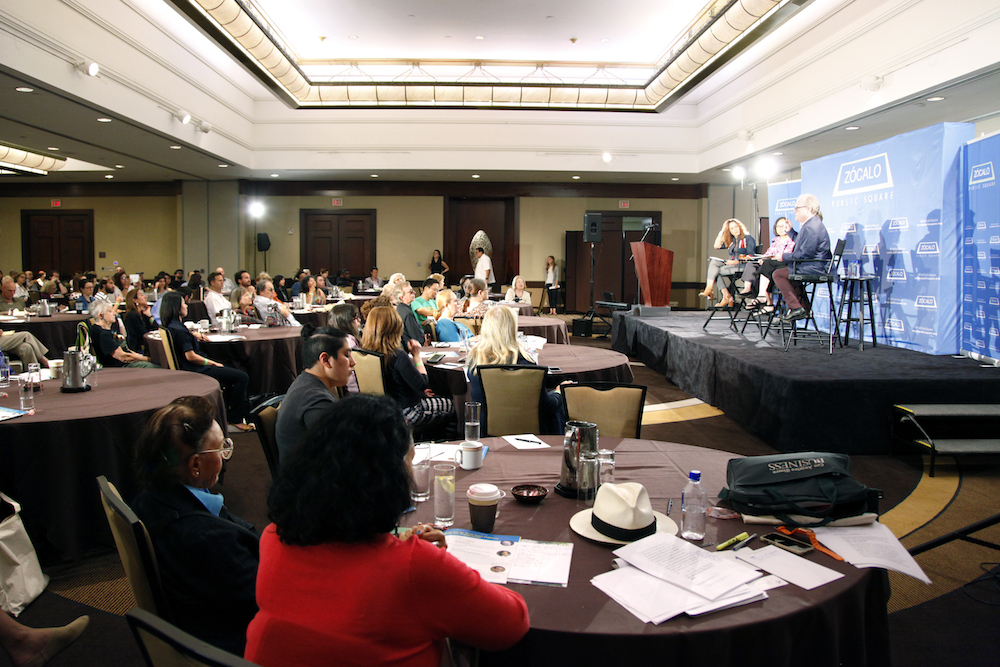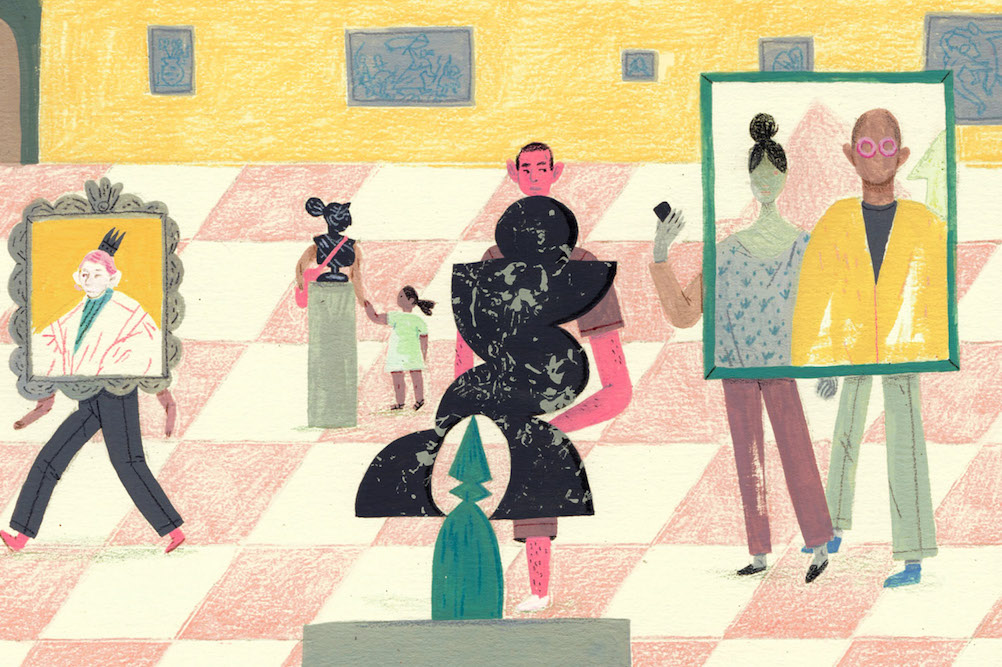
Lynne Conner, Lyne Sneige, Gail Dexter Lord, Luz María Sánchez, and Suse Anderson partake in a panel discussion, "Does Art Really Make Us Better Citizens?" Photo by Aaron Salcido.
If the essence of art is necessarily elusive and hard to define, so too is the essence of arts engagement. As audiences grow more diverse and demanding, and new digital technologies allow anyone to become a content creator with the click of a button, arts engagement now embraces a wide array of strategies, methods and goals.
On June 25 in downtown Los Angeles, more than 200 artists, producers, presenters, grant-makers, museum directors, curators, librarians, cultural administrators, government officials, members of philanthropic entities and journalists came together to consider “What Can the World Teach California About Arts Engagement?” The Zócalo Public Square conference attracted panelists and attendees from across California, the United States and other corners of the planet.
The gathering at the Omni Hotel began with welcoming remarks from Michael Alexander, executive director emeritus of Los Angeles’s Grand Performances series of free outdoor cultural events, followed by a live performance by The Industry, the Los Angeles-based, independent, artist-driven experimental opera company led by artistic director Yuval Sharon.
To frame the day’s conversation, Sharon cited Bertolt Brecht’s adage that “a theater which makes no contact with the public is a nonsense.” Engagement is key to making art that is “responsive to our communities” and “to the times we’re living in,” and that enables us to address our hopes and fears, he concluded.
But how do artists tap into those communities? And does the public even know what it wants from the arts?
Chris Jones, chief theater critic of the Chicago Tribune, took up that question in the day’s first panel discussion. Jones flipped the question on its head, pointing out that some artists feel no obligation whatsoever to please their audiences, convinced that instead their main duty is to please themselves.
In response, panelist Randi Korn, who leads a Virginia-based museum planning firm, and has conducted extensive research on museum audiences, suggested that the real challenge for culture producers is how to create the memorable and meaningful experiences that arise “from people being surprised by what they see.”
“It’s not about meeting people’s expectations,” Korn said. “It’s about exceeding them.”
Another panelist, Cristina King Miranda, a Mexico City-based performing arts curator, suggested that being part of an audience requires its members to connect with each other, and not shy from the debate, conflict and even pain that great art sometimes provokes. “We need to become cartographers of our own experiences in our communities,” she said.
Leslie A. Ito, president of the Japanese American Cultural & Community Center, said that culture producers should be asking themselves how to create the kind of cultural spaces that encourage the fullest participation. She said that her center is presenting more non-Japanese artists in order to connect with the rest of Greater Los Angeles, but also was careful “to ground them in Japanese culture.” For a recent series on world dance music, for example, “we brought artists in for orientation that started with a tea ceremony—so they understand the space and the history of the place in which they are performing,” Ito said.
The conversation also took up the issue of how digital “sharing” and social media have conditioned audiences to seek out cultural events that make cool Facebook posts and generate dozens of Instagram “likes.” Korn warned against “superficial” arts experiences that rely on ginning up Snapchat and Twitter traffic. To make an impact, she said, you “want to be about deepening experience,” as opposed to broadening the arts experience.
Yet the panel concurred that arts and cultural organizations can engage wider audiences, and new audience segments, without pandering to them. Ito cited one New York Historical Society exhibition about taxi drivers that extended its hours from 2 to 6 a.m. to accommodate cabbies working the graveyard shift.
When Jones pressed about how the arts might survive if arts organizations offer collections that are a whole lot of “non-interactive stuff,” panelists said the ability to be in the presence of great stuff (otherwise known as art) still reliably draws audiences and keeps them coming back. “It’s about the intimacy of being with stuff,” said Ito, who recalled visiting a theater in Kyoto, Japan with a very small performance space, no bigger than a table, and the impact of experiencing art in such close, personal quarters.
Jones also pressed the panel on whether the arts must present ways of talking and interacting with people with whom we sharply disagree—particularly in stressed-out, polarized eras like the present. King Miranda responded by making a distinction between “normalization” and “democratization.” She noted that in Mexico, where the state “has failed us” in protecting “security, peace, and justice,” the arts represent a form of resistance.
“The arts remind us of our otherness and our normalness,” King Miranda said.
The morning panel’s exchange set the stage for Steven J. Tepper to deliver the lunchtime keynote address, entitled “Does Arts Engagement Even Matter?” Tepper, the Dean of Arizona State University’s Herberger Institute for Design & the Arts, structured his talk around a transitional process that he described as moving from “Me Experiences” to “Bigger-Than-Me Experiences.”
In the 19th and early 20th centuries, Americans generated much of their own art by themselves and at home, through playing parlor piano, reciting Shakespeare around the dinner table, and other exercises in Emersonian self-reliance. All that changed with the introduction of radio, sound recordings, movie theaters, and other forms of industrially produced mass entertainment. The audience’s role increasingly was reduced to coming to a large venue, sitting in a darkened room, then applauding on cue.
“We saw the rise of cathedrals of consumption,” Tepper said. “It distinctly removed arts and culture from our everyday lives and put it in other places.”
That paradigm persisted through the decades following World War II. But a Wallace Foundation study later recorded a sharp drop in participation in benchmark arts events, setting off some hand-wringing and soul-searching among the cultural cognoscenti.
What was missing in this analysis, Tepper said, was that new forms of engagement were emerging to replace the old ones, leading to a “renaissance” of engagement, in cultural as well as civil life. That ongoing renaissance has been powered by what sociologist C. Wright Mills called “the exuberant expression of self,” which Tepper reframed as the culture of the “I Want What I Want When and How I Want It” generation.
Tepper said he’d taken his daughter to a Taylor Swift concert at which costumed fans posed in front of Taylor Swift-branded props that had been set up to give fangirls a place to snap selfies. Meanwhile, Tepper said, his son has been ordering personally customized Nike shoes.
They’re all symptoms of a phenomenon that Tepper calls the “Curatorial Me.” But if that sounds hopelessly self-absorbed, it also is the phenomenon behind the soaring numbers of people who are buying musical instruments, making their own music, uploading 6 billion hours of content each month onto YouTube, and teaching themselves other new creative pursuits.
Has the pendulum swung too far toward cultural self-expression and consumer autonomy? Studies suggest that this overstimulating our brains may limit capacity for empathy, our receptivity to others’ stories and others’ lives, Tepper said.
Tepper added that “Bigger-Than-Me Experiences” are about purpose more than pleasure, about transformation rather than merely “doing,” about identification rather than identity, and about the “empathetic imagination” rather than the “egoist imagination.” Millennials have shown that they value immersive experiences, diversity, loyalty and the “slow-down economy,” which can be glimpsed in the comeback of vinyl records, the resurgence of community darkrooms, and the popularity of mass group experiences like the Coachella music festival.
“Something about re-immersing ourselves in these shared experiences is extremely powerful for the millennials,” Tepper said.
Alexander then took the floor again to direct an informal exchange among conference attendees, who were encouraged to share their own ideas about arts engagement. One conferee, a library historian, said that museums and theaters could learn a valuable lesson from libraries. “The message that I can bring you from library history is … [if you] provide access and content” you’ll maintain your value, she said.
The discussion moved deeper into the political realm with the day’s third panel talk, “Does Art Really Make Us Better Citizens?” Lynne Conner, a University of North Carolina at Charlotte cultural historian, said that our experiences as members of arts audiences have the potential to teach us how to be better citizens—by learning how to be free thinkers. She added that arts participation can be a means of “rehearsing citizenship.”
Luz María Sánchez, arts and humanities chair of the Universidad Autónoma Metropolitana de México, Lerma, argued that arts serve society and citizenship in three ways. First, the arts are one of the best ways humans have to include people whose voices aren’t being heard.
Second, she noted that in arts work she had done in San Antonio, Texas and Matamoros, Mexico, art could make people more aware of the places they live, and empower them to improve communities. And third, the arts can democratize knowledge. “It is a better way to make outside knowledge, that is being made in the university, and get it out in the proper way and socialize concepts around it,” she said.
In response to a question about the connection between art and citizenship in the Middle East from moderator Suse Anderson, an assistant professor of museum studies at George Washington University, Lyne Sneige, director of the Middle East Institute Arts & Culture Program, said that arts play huge roles in social transformations and in response to conflict. As illustrated by the Arab Spring, she said, “the arts have been the way in which younger generations have resisted in a non-violent way … and the way that they have really demanded that they be treated as citizens in a dignified and respectful way.”
The global arts consultant Gail Dexter Lord said that the arts constitute “a soft power” that influences people’s behavior as citizens through persuasion and agenda setting. Such persuasion can be good—she said that 19th-century novels fostered readers’ empathy and provided the foundation of the modern human rights movement. And she noted that cities around the world have become welcoming places where artists and newcomers can champion notions of citizenship that serve as a check on states that rely on the “hard power” of war and violence.
But, she added, people with ill intentions can also use the arts to try to persuade or set an agenda. “My theory is that art makes some people better citizens, and some people worse citizens,” she said.
So how are the arts and artists innovating to take up these myriad challenges to reach broader audiences? Moderator Seth Porges, a technology writer and television personality, led the day’s third panel in chewing over that question. For New Orleans-based visual artist Brandan “BMike” Odums, an answer has been doing stealth mural interventions in New Orleans public housing complexes that were abandoned in the wake of the 2005 Hurricane Katrina disaster. Odums said he didn’t view these buildings as “blank canvasses” for making art, but as spaces that had histories and told pre-existing stories, and where a shared “level of struggle” was required of those wanting to share in the experience.
“You had to physically get dirty with the space and consequently to ask questions about what could be in that space and what should be in that space,” Odums said.
Lydia Steier, a Connecticut-born opera director who has been living and working in Europe for the last 15 years, emphasized the importance of having a public funding stream for the arts, as is far more common in European countries than the United States. That financial security allows for greater freedom to experiment with content and form, and permits occasional failure. In the United States, she said, the reliance on private money creates an artistic environment that is generally more conservative.
“The reason people [in America] think [opera] is an uncool art for uncool people is because you need funders who tend to be old rich white ladies,” Steier explained. “You’re looking at extremely traditional productions, corsets, the big wigs.”
Rosa Ferré, exhibitions chief at the Centre de Cultura Contemporània de Barcelona, stressed the importance of helping audiences to grasp the relevance and context of artistic expression.
“I think that going to new audiences you need to have risk, you have to have the possibility of failure,” she said, recounting how hard it had been to persuade her board to do an exhibition on Big Data.
In a concluding keynote, Boon Hui Tan, the Asia Society’s vice president for global arts programming, warned against blockbuster exhibitions and attempts to define arts as global.
In this era, the former director of the Singapore Art Museum said, “the purpose of the arts is to awaken a sense of empathy—towards other lives.” With so many social, political, and economic forces creating a situation in which lines are drawn, “the purpose of the arts now is to scratch that line.” Specifically, that requires the arts to help build people’s “ability to read ambiguity,” though that is challenging because “the way things are funded” can encourage simplification or “dumbing down” of art.
“We need, across all sectors of art, to teach people how to engage with complex and ambiguous ideas,” he said.
He championed a “comparative approach” in which a specific locality connects its arts with those of a geographically or historically distant place. He mentioned efforts from Indonesia to Holland to do that kind of comparative work.
Finally, he argued that children’s exhibitions can be particularly powerful in reaching people, and he argued for creating physical spaces for communities (he noted powerful examples from Japan to France) and physical links between neighboring arts institutions so that people find their ways between them.
That brought the day full circle to a point made by emcee Michael Alexander several hours earlier, paraphrasing an observation made by late UCLA musicologist Charles Seeger. “The question is not whether the art is good,” Alexander said. “It’s what the art is good for.”






Send A Letter To the Editors